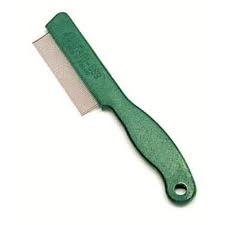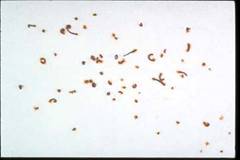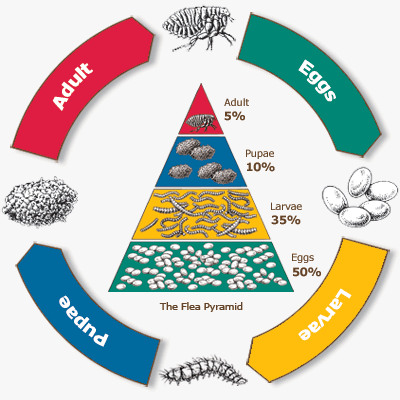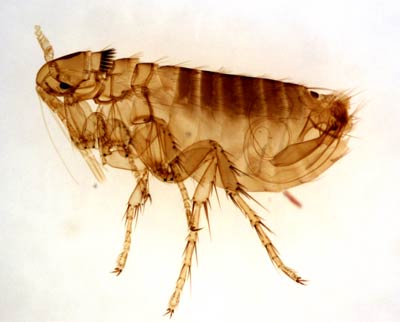Fleas are one of THE most common reasons that dog and cat owners seek out a Veterinary clinic, yet unfortunately all that the Veterinarian can offer is a variety of potentially toxic insecticides. Dog and Cat owners are becoming increasingly concerned about the high number of side effects from conventional flea medication, and many are seeking some of the safer, holistic options of natural flea control.
In this article I will cover basic information on fleas, How to tell if your pet has fleas, medical problems of fleas, the Flea life cycle, and conclude with my TOP natural ways of getting rid of fleas.
Side Effects of Conventional Flea Medication
Conventional Flea medications are increasingly causing medical problems for dogs and cats. In fact while I was in Veterinary practice, I commonly saw small dogs and cats with side effects of the medication. Signs ranged from skin irritation, to hair loss, to vomiting and diarrhea, seizures and in a few cases cats died.
Here is a report from the EPA:
The U.S. Environmental Protection Agency is warning dog and cat owners about potential health risks to their animals from a variety of spot-on flea and tick medications.
Spot-on products generally are sold in tubes or vials and are applied to one or more areas on the body of the animal, such as in between the shoulders or in a stripe along the back.
More than 44,000 pet health-related incidents from spot-on treatments were reported last year to the EPA, ranging from mild skin irritations to death. As a result, the EPA recently announced it was intensifying its evaluation of these products.
The EPA investigation will center on incidents with spot-on treatments, sprays, collars and shampoos.
“However, the majority of the potential incidents reported to EPA are related to flea and tick treatments with EPA-registered spot-on products,” the EPA announced.
Pesticide registrants are required by law to submit information to the EPA on adverse effects resulting from the use of any registered pesticide. EPA said seven products represent about 80 percent of all adverse incidents.
These medications are potentially very toxic, with serious consequences.
This does not even take into account the diseases that are more difficult to link to topical insecticides. By applying a topical flea medication such as Advantage to your dog or cat means that every time your pet grooms themselves, they are ingesting some of that insecticide.
Every time you touch your pet, you are then being exposed to some of that insecticide.
I suspect that this chronic exposure to insecticides wears on your pet’s immune system, leading to increasing incidences of diseases, such as allergies and cancer.
Cancer has risen to epidemic proportions in the dog population with nearly 50% of the dogs dying of cancer.
The Veterinary community, along with large pharmaceutical companies are minimizing these risks, yet many pet owners are becoming alarmed, and rightfully so.
This article will give you some of the more effective natural flea control methods.
How to tell if your pet has fleas
Itch, Itch, Itch!!! Your pet will not stop scratching. If you look more closely you will probably see flecks of black dirt; this is flea feces. A sure way to test for fleas is by placing your pet over a white piece of paper and vigorously rubbing her fur. If black ‘dirt’ (flea feces) falls off, then she has fleas. You may also be able to see the little guys jumping; using a small fine-toothed comb you may be able to find them.
Flea combs are fine teethed combs that are able to pick up flea dirt ( flea poop), flea eggs and adult fleas.

1. Start from the head, and comb backwards.
2. If you find black specs ( flea poop) place it on a white piece of paper and add water. If it turns red, your pet has fleas.
3. Place the eggs, fleas and flea dirt in soapy water ( this will kill the fleas)
4. If your pet has fleas or lice, repeat this twice a day.
5. Preventively check your pet for fleas/lice once a week.

Flea Dirt
Flea Information
Fleas are the most common dog and cat external parasite, living off your pet’s blood.
Some flea species include:
– Cat flea (Ctenocephalides felis)
– Dog flea (Ctenocephalides canis)
Over 2,000 species have been described worldwide
– Fleas are small wingless insects with mouth-parts that allow them to feed on the blood of your pet. They have long legs adapted for jumping, then can jump up to 200 times their own body length.
Medical Problems of Fleas
Fleas can cause a whole host of medical concerns for dogs and cats.
Skin conditions are most common, and this includes flea allergy dermatitis (FAD), hair loss, hot spots, excoriations showing up as irritated red skin.
More serious medical conditions of fleas include tapeworms ( very common in cats), and in serious infestation, anemia. In young puppies and kittens this could result in death.
Fleas have been implicated in transmitting the bubonic plague. They transmit the bacteria Yersina between rodents and humans.
They are other lesser know and unusual diseases that are transmitted by fleas, but these are very uncommon in North America.
Flea Life Cycle
Understanding the Flea Life Cycle is important to be able to control fleas naturally.

Fleas have a life cycle of 4 parts: egg, larva, pupa and adult.
Common percentages of flea populations include: 50% eggs, 35% larvae, 10% pupae and 5% adults.
The life cycle from egg to adult can be rapid or slow, varying from two weeks to eight months. This is dependent on a variety of factors: humidity, temperature, and availability of food ( the blood of your pet!!)
After feeding on blood, the female flea can lay 50 eggs per day with a maximum of 600 eggs on your dog or cat.
Flea eggs are not firmly attached, and they fall out where your pet lays down or sleeps. In contrast lice lay eggs that are firmly attached, and most of their life cycle is on your dog.
Eggs turn into larvae, and that takes anywhere from 2 days to 2 weeks. Inside the larvae are found in cracks and crevices, your pet’s bed, kennel or edges of your house.
The larvae also develop outside – they are especially adapted to sand and gravel.
Adult fleas need blood to survive and lay eggs, but may live for one year without feeding. When you leave your house for a period of time, flea eggs hatch and larvae pupate.
The fleas fully develop in the pupae, and can survive for up to a year so long as they do not emerge- waiting for your pets to return and hatch ‘en masse’.
In 30 days, 10 female fleas can increase to over 250,000.
Optimum temperatures for the fleas are 70°F to 85°F and optimum humidity is 70%.
NATURAL WAYS TO GET RID OF FLEAS
So where do you start?
According to ‘conventional’ veterinary wisdom, most pet owners are given ONLY one option, some sort of potentially toxic insecticide.
My advice is to incorporate a number of natural flea control methods, using the conventional options in severe infestations, or when the natural remedies are not working.
In treating fleas naturally, you need to focus on 3 areas of flea control: Flea control on your pet, Flea control in your house, and Flea control in your yard.
1.NATURAL FLEA CONTROL ON YOUR PET
A HEALTHY PET. A healthy pet will have less of a problem with fleas than an unhealthy one. If your pet has a skin problem such as an allergy caused by food, fleas will make the irritation worse, and may reproduce that much quicker because they have an easier time feeding on weakened skin. Do all that you can to boost your pet’s immune system – you may find that just by improving your pet’s overall health, you will gain control of your flea problems. To help boost your pet’s immune system, use a natural health supplement such as my own :
Ultimate Canine Health Formula
Ultimate Feline Health Formula
Flea Comb your pet regularly. Flea combs are fine teethed combs that are able to pick up flea dirt ( flea poop), flea eggs and adult fleas.
1. Start from the head, and comb backwards.
2. If you find black specs ( flea poop) place it on a white piece of paper and add water. If it turns red, your pet has fleas.
3. Place the eggs, fleas and flea dirt in soapy water ( this will kill the fleas)
4.If your pet has fleas or lice, repeat this twice a day.
5. Preventively check your pet for fleas/lice once a week.
SHAMPOO. Bathing is effective at soothing irritated skin and eliminating some of the adult fleas. There are a number of flea shampoos combined with oatmeal. Use cool water and leave the shampoo on for 10 minutes.. Your pet can be safely shampooed twice a week. There are a number of effective holistic flea shampoos that are reasonably effective. Some of ingredients that work for dogs and cats include Neem oil, Eucalyptus and Cedarwood oil.
Avoid Tea Tree oil – it is very toxic to cats, and small dogs, although found in some of the ‘natural’ flea control products.
Conventional Flea shampoos that contain pyrethrins are the safest type of conventional flea and lice treatment- I advise using these shampoos for dogs, cats, puppies and kittens.
MAKE YOUR PET TASTE BAD. Garlic and Brewer’s Yeast have been advocated as a way of repelling fleas. In my experience it only seems to help a small number of dogs, but it is worth a try. Garlic is not safe to give to cats long term. For a 10 lb dog, give 1/4 tsp of garlic and 1/4 tbsp of brewer’s yeast daily.
MULLEIN. Make as a decoction/tea and rinse on your pet. Get a handful of the herb, steep in hot water, cool and pour over your dog or cat. This will temporarily paralyze the fleas.
CEDARWOOD OIL SPRAY: A relatively non-toxic natural substance, has been proven effective in the eradication of infestations in pets. Be cautious in spraying any type of essential oil on cats or small dogs, only lightly mist them, then use a flea comb to spread the spay around. Here is a recognized safe cedarwood oil flea spray for dogs and cats: Triple Sure Natural Flea and Tick Spray made by Natural Wonder Products.
BORAX. This is another home treatment for flea infestations. Borax kills fleas by dehydrating them.
2. FLEA CONTROL IN YOUR HOUSE
SUCK THEM UP AND WASH AWAY. Thoroughly vacuum the areas where your pet spends time. Concentrate on bedding, carpet, cracks and crevices. Regularly wash your pet’s bedding. Do not forget about the car. Steam cleaning your carpets is an even more effective method of killing fleas, larvae, and eggs.
CHINCHILLA DUST. This is correctly called ‘diatomaceous earth,’ which consists of the skeletons of microscopic algae. It can be purchased in pet supply stores, but be sure it is the kind meant for pets, not the glassified type which is used in swimming pool filters. It can be used on your pet and in the house. Apply it weekly during flea season, vacuuming 3 days after applying. Make a point of putting it in the cracks and crevices. This can also be safely applied to your dog or cat.
WEEKLY WASH: Wash your pet’s bedding in hot water at least once a week. Carefully roll up the bedding so as to not lose the eggs which could drop off. Washing will the fleas, removing the eggs, larvae and pupae
DEHUMIDIFY. Humidity is vital for flea survival. Flea eggs need humidity of 75% to hatch, flea larvae need 50% humidity to survive. For example in places with adequate humidity, 20% of the eggs survive. In dry areas with LOW humidity, less than 5% of the eggs survive. Using a dehumidifier in your home will go a long way in stopping the flea cycle.
3. FLEA CONTROL IN YOUR YARD
NATURAL CONTROL IN YOUR YARD. Nematodes are microscopic worms that prey on the larvae and pupae of fleas. They can be purchased at most garden stores; a small canister contains 100 million little worms. Follow the label directions, spraying them on the damp bushy areas in your yard.
SHORT LAWN. Keeping the grass short allows the sun to shine on the larvae killing them. The goal here is to make it uncomfortable for the fleas to reproduce.
ANTS ARE GOOD. They will eat flea eggs and larvae – so longs as they are not eating your house, then keep them alive to interrupt the flea life cycle.
NATURAL TOPICALS OUTSIDE. Diatomaceous earth, which consists of the skeletons of microscopic algae. It can be purchased in pet supply stores, but be sure it is the kind meant for pets, not the glassified type which is used in swimming pool filters. It can be used on your pet and in the house and on areas where your pet sleeps outside.
Dr Andrew Jones is the owner of the Nelson Animal Hospital, a former practicing Veterinarian with 17 years experience, and author of numerous alternative dog and cat health books and publications.
For Dr Jones newest video and special Report on ALL of his TOP ways to get rid of fleas Naturally go to: How to Get Rid of Fleas Naturally and Avoid Toxic Insecticides








